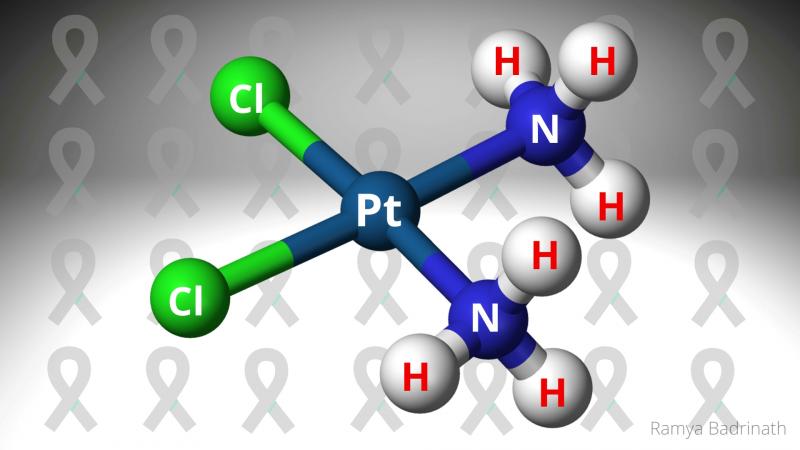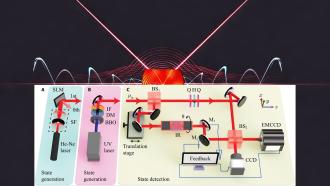
In India, one woman dies of cervical cancer every 8 minutes, and for every two women newly diagnosed with breast cancer, one succumbs to it. In 2018, all over the country, 7,84,821 people lost their lives to cancer. Numerous scientific research is underway to discover new and improved drugs for cancer. Chemotherapy, where anti-cancer drugs are administered to kill cancerous cells, is one of the traditional and most successful treatment methods. In a recent study, Dr Sumit Ghosh, from the Indian Institute of Technology, Kanpur, discusses cisplatin, the first-ever metal-based drug used in chemotherapy.
Cancer is a condition where cells divide rapidly, without control, giving rise to a mass of cells called a tumour. These are abnormal cells and can originate from anywhere in the body. Healthy cells turn cancerous due to genetic mutations or carcinogens like ultraviolet radiation, arsenic, asbestos and tobacco. Some times, infections from bacteria, viruses and parasites, like the human papillomavirus, can also cause cancer.
Cisplatin is a platinum-based chemotherapy drug that has been approved by the FDA for the treatment of a wide range of cancers like testicular, ovarian, lung, breast, bladder, cervical, head and neck cancer, gastric cancer and some other types of cancer. In 1845, Italian chemist Michele Peyrone discovered and synthesised cisplatin. However, its anti-cancer properties were first found accidentally by the American chemist Barnett Rosenberg in 1965.
Cisplatin acts on cancerous cells in many ways. But the most well-understood approach is one where cisplatin brings about programmed cell death, known as apoptosis in cancer cells. It causes damage to the cells' genomic DNA or mitochondrial DNA, thus blocking its replication and repair. As a result, a chain of reactions starts, which brings about apoptosis.
Although highly effective, cisplatin has side effects caused by overdose. Since the excess cisplatin is excreted through urine, it gets accumulated in the kidneys, causing toxicity. In children, the drug causes hearing loss due to the increased production of unstable oxygen molecules that damage the DNA in the cochlear cells. The increased levels of certain enzymes in the liver, gastrointestinal tract and the neural tissues also result in toxicity.
Sometimes, cancer cells develop resistance to cisplatin therapy, resulting in a relapse of the disease. The drug resistance, thus formed, could be either at the start of the treatment or during the later stages. This development of resistance could be due to four reasons. Firstly, when the drug circulates in the blood, the plasma proteins like albumin and cysteine bind with it and deactivate it. Sometimes, the cancer cells could absorb less of the drug and discard the rest, making it ineffective. Thirdly, inside the cell, specific antioxidant molecules could bind to cisplatin, inactivating it. Other times, the cells' DNA repair mechanism successfully repairs the DNA damage caused by cisplatin, restoring its ability to survive and reproduce.
Doctors are now using combination therapy, where two or more different chemicals, which act differently on cancer cells, are used along with cisplatin, to reduce the side effects of cisplatin and overcome the problem of resistance. Researchers are also looking for new drugs that are equivalent to cisplatin but have fewer side effects and improved effect on drug resistance. Some of such 'cisplatin analog' drugs are carboplatin, oxaliplatin, heptaplatin, lobaplatin and satraplatin, some of which are already clinically approved and are in use. All of these drugs show relatively lower levels of toxicity and resistance with no decline in its anti-cancer properties.
With the advent of nano drugs, the future of cancer therapy using metal-based drugs is exciting. In nanoscale drug delivery, nanoparticles transport the active drugs through the circulatory system to the target cells. Cisplatin is conjugated with carbon nanotubes (50-200nm) or gold nanoparticles to aid in nanoscale delivery. This approach reduces the toxic effects of drugs as it is transported to the target cells only. Certain chemicals on the nanoparticles have a receptor, which can bind only to the surface of the targeted cancer cells, thus achieving cell-specific drug delivery.
"More research is needed to improve anti-cancer activity, reduce toxicity and resistance of cisplatin, especially in the field of nanoparticle drug delivery by using cisplatin-analog drugs," says Dr Ghosh.






